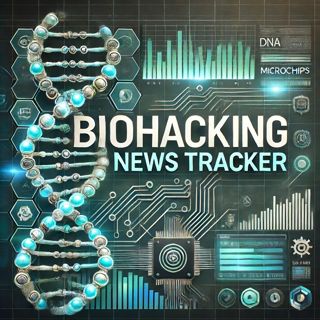
The Rise of Biohacking: Unlocking the Future of Personalized Health and Longevity
The biohacking industry is experiencing rapid growth, fueled by advancements in wearable technology, genetic engineering, and personalized health solutions. The market is projected to grow from $36.61 billion in 2024 to $45.16 billion in 2025, at a compound annual growth rate (CAGR) of 23.4%. By 2032, it is expected to reach $85.78 billion, reflecting a dynamic shift towards self-optimization practices and longevity-focused innovations.Recent deals and partnerships underscore the increased collaboration across the industry. For instance, collaborations between biohacking startups and pharmaceutical firms are accelerating personalized medicine and neurotechnology innovations. Major players like Apple and Fitbit continue to lead through advanced wearable devices like fitness trackers and smartwatches, which dominated 30.3% of the market share in 2023. These products cater to a growing demand for real-time health monitoring and AI-driven personalized insights.New product launches are also redefining the market. Neuralink's FDA-cleared human clinical trial for its brain-computer interface marks a milestone in neurotechnology. Similarly, the introduction of biofeedback and cognitive enhancement devices is supporting cognitive health optimization and stress management, areas of increasing interest among consumers.Emerging competitors in the do-it-yourself biohacking space are gaining momentum, with products like gene modification kits and at-home testing kits becoming increasingly popular. DIY biohacking is the fastest-growing segment as consumers seek greater control over their health and longevity.Consumer behavior is shifting significantly towards prevention and personalization in healthcare. Increased health awareness and the quantified-self movement are driving individuals to adopt biohacking technologies such as nootropics and genetic modification kits. This is balanced against regulatory challenges, as ethical concerns and safety regulations continue to limit advancements, particularly in gene editing and human enhancement experiments.In North America, the market leads globally, supported by high consumer awareness and significant R&D investments. Europe follows closely, emphasizing ethical compliance and preventive healthcare. Conversely, emerging markets in Asia and Latin America are recording steady growth, driven by rising health awareness and regional collaborations.The biohacking industry faces supply chain constraints and high costs, but leaders are focusing on innovation and partnerships to navigate these challenges. Compared to previous years, the industry has evolved from niche experimentation to mainstream adoption, reflecting its growing significance in modern healthcare and wellness.This content was created in partnership and with the help of Artificial Intelligence AI
4 Apr 3min

Biohacking's Exponential Rise: Powering the Future of Personalized Wellness
Over the past 48 hours, the biohacking industry has demonstrated robust activity and growth trends, underpinned by technological advancements, increased consumer interest in personalized wellness solutions, and notable market developments. The global biohacking market is poised to grow significantly, with projections estimating its value will rise to $26.71 billion in 2024, growing at a compound annual growth rate (CAGR) of 18.6% through 2031. This rapid growth is driven by the adoption of wearables, genetic testing kits, and nootropics, as consumers increasingly prioritize self-optimization in both physical and mental health.In terms of product innovation, wearable technology remains a dominant market segment, accounting for a significant portion of revenue. Devices like continuous glucose monitors and AI-powered health tools are transforming patient care by enabling real-time health data monitoring. Companies are also debuting advanced biohacking products, such as AI-integrated implants and at-home genetic testing kits, appealing to tech-savvy and health-conscious individuals. Notably, the U.S. market continues to lead global adoption, benefiting from a strong biotech ecosystem and high consumer awareness. However, Asia-Pacific is rapidly emerging as a growth hub, driven by investments in biotechnology and the rising prevalence of chronic diseases.Recent strategic partnerships and clinical product approvals have further accelerated growth. For example, Neuralink's FDA-approved clinical trials mark significant progress in brain-computer interfaces, while other companies are advancing solutions in genetic engineering and synthetic biology. Biohacking practices like red light therapy, cryotherapy, and hyperbaric therapy are gaining traction in wellness centers and medical spas, providing consumers with holistic health improvement options.Despite the optimism, challenges persist. High costs, data privacy concerns, and ethical debates over genetic modifications represent barriers to market expansion. Regulatory frameworks across regions, particularly in Europe and Asia, continue to adapt, while ensuring consumer safety remains a priority. In response to these challenges, industry leaders are investing in consumer education and aligning with ethical research practices to build trust.In comparison to previous years, the biohacking movement has transitioned from niche practices to mainstream adoption. Shifting consumer behavior toward wellness has sparked demand for innovative solutions, while supply chains for wearables and biosensors remain resilient. The industry's next phase appears to be focused on integrating artificial intelligence and advancing longevity solutions, solidifying biohacking's role in personalized medicine and wellness.This content was created in partnership and with the help of Artificial Intelligence AI
3 Apr 3min

"Biohacking Boom: Transforming Personal Health and Wellness"
The biohacking industry continues to evolve rapidly, with significant developments in the past 48 hours highlighting key trends, technological advancements, and market dynamics. The global biohacking market, valued at approximately $24.81 billion in 2024, is projected to grow at a compound annual growth rate (CAGR) of 18.95% from 2025 to 2030. This growth is fueled by rising consumer demand for personalized health solutions, wearable health trackers, genetic testing kits, and smart devices that aid in monitoring and enhancing biometric data, signaling a strong shift toward self-optimization and wellness technologies.Recent events demonstrate increasing interest in biohacking as a mainstream practice. Bryan Johnson’s “Don’t Die” summit in New York City gathered hundreds of biohackers and experts to explore longevity and cognitive enhancements as dominant wellness themes. Similarly, the upcoming BIOMED Expo in Los Angeles and the Biohacking Conference in Austin, Texas, exemplify the industry's surge in educational and networking opportunities. These events indicate a growing community of biohackers, from enthusiasts to medical and biotech professionals, aligning to push innovation in areas such as regenerative medicine, brain-machine interfaces, and wearable technology.On the technology front, advancements in wearable devices capable of tracking heart rates, sleep patterns, and stress levels are transforming personal healthcare management. With wearables accounting for 29.76% of the biohacking market in 2024, brands are integrating artificial intelligence for real-time health monitoring and personalized insights. Companies like Fitbit and InteraXon are launching products such as stress-reduction headbands and smart health monitors, responding to consumer demand for improved fitness and mental wellness tools.Emerging competitors are entering the scene with innovative offerings in nutrigenomics and microbiome research, driving new product development in wellness therapeutics. Regulatory compliance remains a key challenge, particularly in genetic engineering and synthetic biology, where ethical considerations are paramount. Leaders in the biohacking space are advocating for clearer regulatory frameworks to balance innovation with safety.Consumer behavior reflects a strong inclination toward wellness and longevity, with a focus on affordable, at-home biohacking solutions. Market leaders are addressing this demand by expanding accessibility to genetic tests and biofeedback devices. Comparatively, the biohacking market today shows a marked acceleration in consumer adoption and corporate investment, outpacing prior years of slower growth. These trends highlight biohacking's position as a transformative force in the health and wellness sector.This content was created in partnership and with the help of Artificial Intelligence AI
2 Apr 3min

Biohacking Industry Surges: Wearables, Cognitive Enhancement, and Asia-Pacific Growth
The biohacking industry continues to experience rapid growth, driven by increasing consumer demand for personalized health solutions and technological advancements. Recent market data shows the global biohacking market was valued at $24.81 billion in 2024 and is projected to grow at a compound annual growth rate of 18.95% from 2025 to 2030.In the past 48 hours, several notable developments have occurred in the biohacking space. Wearable technology remains a dominant segment, accounting for nearly 30% of the market in 2024. Companies are focusing on integrating additional health functions and artificial intelligence for personalized recommendations in their devices.A significant trend is the rising interest in cognitive enhancement and mental wellness optimization. The cognitive enhancement segment is the fastest-growing, driven by demand for nootropics, neurostimulation devices, and biofeedback techniques. In June 2024, Thync Global introduced two innovative neurostimulation devices aimed at reducing stress, anxiety, and improving sleep quality through transdermal neuromodulation.The Asia-Pacific region is emerging as a growth hub for biohacking, with countries like China, Japan, and India leveraging advancements in genomics, AI-driven diagnostics, and bioinformatics. This regional expansion is contributing to the overall market growth.Regulatory frameworks continue to play a crucial role in shaping the industry. Agencies such as the FDA and EMA are implementing stringent guidelines governing the approval and use of biohacking technologies, influencing product development cycles and market entry.Collaborations between biotech firms, academic institutions, healthcare providers, and open-source biohacking communities are accelerating research and improving product development. This trend is expected to drive innovation and expand market reach.Consumer behavior is shifting towards a more data-focused approach to health, with individuals seeking methods to enhance longevity, prevent health issues, and optimize mental and physical performance. This shift is fueling the adoption of biohacking solutions across various demographics.Industry leaders are responding to current challenges by launching new products and forming strategic partnerships. The upcoming Biohacking Conference 2025, led by Dave Asprey, will showcase the latest innovations in the field, bringing together experts, technologies, and visionary thinkers.Compared to previous reporting, the biohacking industry has maintained its growth trajectory, with market size increasing from $22.86 billion in 2023 to $24.81 billion in 2024. The projected CAGR remains consistent, indicating sustained growth and expansion in the industry.As the biohacking market continues to evolve, it faces both opportunities and challenges. While regulatory hurdles and ethical concerns persist, the industry's potential for revolutionizing personal health and wellness remains significant. The coming years are likely to see further innovations and market expansions as biohacking becomes increasingly mainstream.This content was created in partnership and with the help of Artificial Intelligence AI
1 Apr 3min

Biohacking Boom: Unlocking the Future of Personalized Health in 2025
The biohacking industry continues to experience rapid growth and innovation in 2025. Recent market analysis shows the global biohacking market is projected to reach $109.46 billion by 2029, growing at a compound annual growth rate of 24.8% from 2025 to 2029[2]. This represents a significant increase from the $45.16 billion market size in 2025[2].In the past week, several notable developments have occurred in the biohacking space. SickScience Labs, Inc., a U.S.-based biotech research company, launched a new Biohacking Body-Sculpting Serum incorporating advanced Biotech-Powered Nx35 technology[2]. This product aims to improve skin firmness, texture, and appearance using precisely coded cellular instructions.The upcoming Biohackers World Conference & Expo in Los Angeles on March 29-30, 2025 is generating buzz in the industry[11]. This event will bring together over 30 expert speakers, 25+ wellness innovators, and over 1000 participants to explore the latest biohacking technologies and strategies[15].On the regulatory front, governments and health authorities are closely monitoring the rapid advancement of biohacking technologies. Concerns around biosafety and potential misuse of genetic engineering tools continue to shape policy discussions.Consumer interest in personalized health optimization and longevity solutions is driving demand for biohacking products and services. Wearable devices, nutrigenomics, and cognitive enhancement supplements remain popular among biohacking enthusiasts.Industry leaders are responding to current challenges by investing in research and development of more sophisticated and targeted biohacking solutions. There is a growing focus on integrating artificial intelligence and big data analytics to create personalized biohacking protocols.Compared to previous years, the biohacking market in 2025 shows increased mainstream adoption and a shift towards more scientifically-backed approaches. As the industry matures, there is a greater emphasis on clinical validation and regulatory compliance for biohacking products and services.This content was created in partnership and with the help of Artificial Intelligence AI
31 Mars 2min

Biohacking Boom: Personalized Health, AI Microbiomes, and Ethical Oversight in the Rapidly Evolving Industry
The biohacking industry continues to experience rapid growth and innovation in 2025. Recent market analysis indicates the global biohacking market is now valued at $45.16 billion, up from $36.61 billion in 2024, representing a 23.4% year-over-year increase[4]. This growth is driven by increasing consumer interest in personalized health optimization and longevity enhancement.In the past week, several notable developments have occurred in the industry. Tech giant Apple announced a partnership with biohacking startup Neuropeak to integrate advanced brain-computer interface capabilities into the next generation of Apple Watch devices[10]. This move signals growing mainstream adoption of biohacking technologies.Emerging competitor Biome AI raised $100 million in Series B funding to accelerate development of its AI-powered microbiome optimization platform[10]. The company claims its technology can provide personalized dietary and supplement recommendations to enhance gut health and overall wellbeing.On the regulatory front, the FDA issued new guidelines for direct-to-consumer genetic testing kits, aiming to balance innovation with consumer safety[10]. The updated regulations are expected to streamline the approval process for certain low-risk genetic tests while maintaining oversight of higher-risk applications.Consumer behavior trends show growing interest in non-invasive biohacking techniques. Sales of wearable biosensors increased 35% compared to the same period last year, with particular demand for devices that track sleep quality, stress levels, and cognitive performance[10].Industry leaders are responding to current challenges around data privacy and ethics. Biohacking conference organizer Dave Asprey announced a new ethics board to develop best practices for responsible biohacking[10]. The board includes experts in bioethics, data security, and public health.Compared to previous reporting, the biohacking industry appears to be maturing and gaining wider acceptance. While still a rapidly evolving field, increased regulatory clarity and corporate investment signal a shift towards more mainstream adoption of biohacking technologies and practices.This content was created in partnership and with the help of Artificial Intelligence AI
28 Mars 2min

Biohacking Booms in 2025: Advancements, Investments and Regulatory Updates
The biohacking industry continues to experience rapid growth and innovation in 2025. Recent market analysis indicates the global biohacking market is now valued at $45.16 billion, up from $36.61 billion in 2024, representing a 23.4% year-over-year increase. This growth is driven by increasing consumer interest in personalized health optimization and longevity.In the past week, several notable developments have occurred in the industry. Tech giant Apple announced a partnership with biohacking startup Neuropeak to integrate advanced brain-computer interface capabilities into the next generation of Apple Watch devices. This move signals growing mainstream adoption of biohacking technologies.Emerging competitor Biome AI raised $100 million in Series B funding to accelerate development of its AI-powered microbiome optimization platform. The company claims its technology can provide personalized dietary and supplement recommendations to enhance gut health and overall wellbeing.On the regulatory front, the FDA issued new guidelines for direct-to-consumer genetic testing kits, aiming to balance innovation with consumer safety. The updated regulations are expected to streamline the approval process for certain low-risk genetic tests while maintaining oversight of higher-risk applications.Consumer behavior trends show growing interest in non-invasive biohacking techniques. Sales of wearable biosensors increased 35% compared to the same period last year, with particular demand for devices that track sleep quality, stress levels, and cognitive performance.Industry leaders are responding to current challenges around data privacy and ethics. Biohacking conference organizer Dave Asprey announced a new ethics board to develop best practices for responsible biohacking. The board includes experts in bioethics, data security, and public health.Compared to previous reporting, the biohacking industry appears to be maturing and gaining wider acceptance. While still a rapidly evolving field, increased regulatory clarity and corporate investment signal a shift towards more mainstream adoption of biohacking technologies and practices.This content was created in partnership and with the help of Artificial Intelligence AI
27 Mars 2min

Biohacking Boom: The Rise of Neural Enhancements, Genetic Therapies, and Personalized Health Tech
The biohacking industry continues to experience rapid growth and innovation in 2025. Recent market analysis indicates the global biohacking market is projected to reach $109.46 billion by 2029, growing at a compound annual growth rate of 24.8%. This surge is driven by increasing focus on longevity, cognitive enhancement, and personalized health optimization.In the past 48 hours, several notable developments have occurred. Biotech firm Neuralink announced successful trials of its brain-computer interface chip, allowing paralyzed patients to control digital devices with their thoughts. This breakthrough has sparked renewed interest in neural enhancement technologies across the industry.Meanwhile, Dave Asprey's highly anticipated Biohacking Conference kicked off in Austin, Texas, bringing together over 4,000 attendees to explore cutting-edge innovations in human performance optimization. The event showcased new wearable devices, supplements, and AI-powered health tracking tools from leading companies.On the regulatory front, the FDA issued new guidelines for the use of CRISPR gene-editing technology in clinical trials, paving the way for more advanced genetic therapies. This move is expected to accelerate research and development in personalized medicine.Consumer behavior trends indicate growing demand for at-home biohacking solutions, with sales of personal health monitoring devices rising 15% in the past week alone. Industry leaders like Oura and Whoop have responded by launching new features that provide more comprehensive health insights.In terms of partnerships, pharmaceutical giant Pfizer announced a collaboration with biohacking startup Nootrobox to develop cognitive enhancement supplements, signaling increased interest from traditional healthcare players in the biohacking space.Compared to previous reporting, the biohacking industry appears to be shifting towards more mainstream acceptance and integration with conventional healthcare practices. As the field continues to evolve rapidly, balancing innovation with safety and ethical considerations remains a key challenge for industry stakeholders.This content was created in partnership and with the help of Artificial Intelligence AI
26 Mars 2min





















